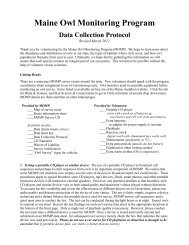Focus Species Forestry - Maine Audubon
Focus Species Forestry - Maine Audubon
Focus Species Forestry - Maine Audubon
You also want an ePaper? Increase the reach of your titles
YUMPU automatically turns print PDFs into web optimized ePapers that Google loves.
Northern Hardwoods<br />
____________________________________________<br />
Overview<br />
Single Tree<br />
Selection<br />
Group Selection<br />
Shelterwood and<br />
Clearcut<br />
Other<br />
<strong>Focus</strong> <strong>Species</strong> Management<br />
Northern hardwoods are adaptable to a wide range of silvicultural practices. The<br />
natural community characteristics of northern hardwoods are best maintained by<br />
single-tree or group selection cutting, while heavier cuts may be used for specific<br />
timber and wildlife objectives.<br />
Well suited to maintaining mature forest and consistent with natural disturbance<br />
patterns.<br />
May be used with caution in maple-basswood-ash forest (a rare natural<br />
community)—avoid soil disturbance and maintain >60% overstory canopy closure.<br />
Use to maintain mature forest while encouraging mid-tolerant species like yellow<br />
birch and ash and creating small patches (up to 2 acres) of early successional<br />
habitat.<br />
Use to create patches of early successional habitat over 2 acres in size and to<br />
regenerate intolerant species or low-quality stands.<br />
Retain patches of mature stands in islands or peninsulas as well as travel<br />
corridors. See stand-level guidelines for details (Section 7).<br />
Return tree tops to the harvest area to prevent nutrient depletion and maintain soil<br />
structure.<br />
Shelterwood harvests can be used to emulate extreme natural disturbances;<br />
lengthening the period before overstory removal will minimize impacts to<br />
herbaceous plants.<br />
Clearcuts have no true natural analogue and require a longer time for ecosystem<br />
recovery.<br />
When clearcuts and shelterwood are used, long rotations (>100 years) may be<br />
necessary to restore mature forest conditions.<br />
Maintain nut-producing oak and beech. Where healthy beech are not present,<br />
even trees with partial live crowns are beneficial to bears and other wildlife.<br />
Maintain inclusions of hemlock, spruce, and other conifers.<br />
Follow recommendations for snags, cavity trees, and downed woody material and<br />
other stand-level guidelines (Section 7).<br />
Refer to landscape-level guidelines for recommendations on integrating<br />
landscape structure and design into stand level-decisions (Section 8).<br />
Mixed Northern Hardwood-Spruce-Fir Forests: In general, for mixedwood stands up to 1/3 spruce-fir and<br />
other softwoods, use the northern hardwood recommendations; for mixedwood stands with 1/3 to 2/3 in<br />
conifers, consider both the northern hardwood and spruce-fir recommendations; for mixedwood with more than<br />
2/3 in conifers, use the spruce-fir recommendations.<br />
References: Carlson 1999 (see Section II, Enriched Hardwood Forests), DeGraaf et al. 1992, DeGraaf and<br />
Yamasaki 2001, Flatebo et al. 1999, Eyre 1980, Leak et al. 1987, MNAP 2001, Seymour 1984, Solomon et al.<br />
1995<br />
<strong>Focus</strong> <strong>Species</strong> <strong>Forestry</strong> 21


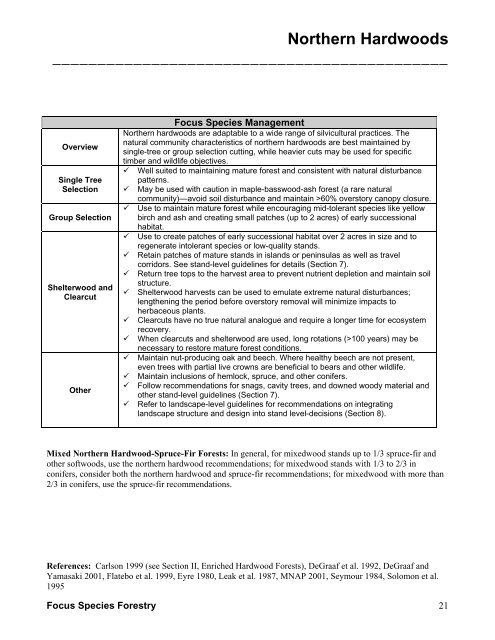
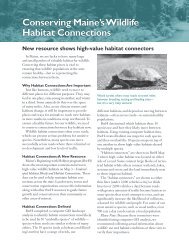
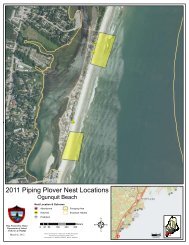
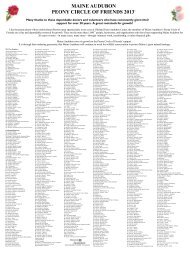
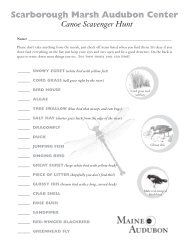


![2012 Loon Count Results [pdf] - Maine Audubon](https://img.yumpu.com/26228732/1/190x245/2012-loon-count-results-pdf-maine-audubon.jpg?quality=85)
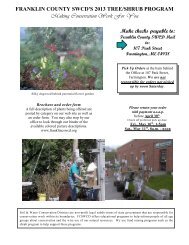
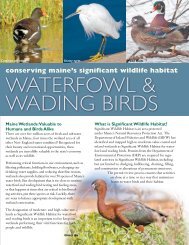
![Lake Fish of Maine (DIFW list) [pdf] - Maine Audubon](https://img.yumpu.com/23282964/1/190x245/lake-fish-of-maine-difw-list-pdf-maine-audubon.jpg?quality=85)
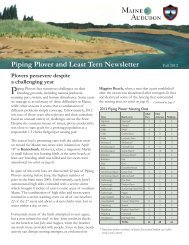

![The Maine Audubon Peony Circle of Friends 2012 [pdf]](https://img.yumpu.com/22707677/1/190x253/the-maine-audubon-peony-circle-of-friends-2012-pdf.jpg?quality=85)
